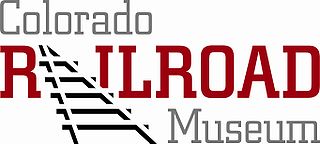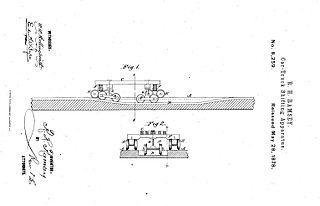
A bogie is a chassis or framework that carries a wheelset, attached to a vehicle—a modular subassembly of wheels and axles. Bogies take various forms in various modes of transport. A bogie may remain normally attached or be quickly detachable ; it may contain a suspension within it, or be solid and in turn be suspended ; it may be mounted on a swivel, as traditionally on a railway carriage or locomotive, additionally jointed and sprung, or held in place by other means.

The Denver & Rio Grande Western Railroad, often shortened to Rio Grande, D&RG or D&RGW, formerly the Denver & Rio Grande Railroad, was an American Class I railroad company. The railroad started as a 3 ft narrow-gauge line running south from Denver, Colorado, in 1870. It served mainly as a transcontinental bridge line between Denver, and Salt Lake City, Utah. The Rio Grande was also a major origin of coal and mineral traffic.

A 2-8-8-4 steam locomotive, under the Whyte notation, has two leading wheels, two sets of eight driving wheels, and a four-wheel trailing truck. The type was generally named the Yellowstone, a name given it by the first owner, the Northern Pacific Railway, whose lines ran near Yellowstone National Park. Seventy-two Yellowstone-type locomotives were built for four U.S. railroads.

The GMC Motorhome is a recreational vehicle that was manufactured by the GMC Truck & Coach Division of General Motors for model years 1973–1978 in Pontiac, Michigan, USA — as the only complete motorhome built by a major auto/truck manufacturer. Manufactured in 23 and 26 ft lengths, the design was noted for its front-wheel drive and its low profile, fully integrated body.

The EMD SD40-2 is a 3,000-horsepower (2,200 kW) C-C diesel-electric locomotive built by EMD from 1972 to 1989.

The EMD SD40 is an American 6-axle diesel-electric locomotive built by General Motors Electro-Motive Division between January 1966 and August 1972. 1,286 locomotives were built between 1966 and 1972. In 1972, an improved version with new electronics was developed and marketed as a new locomotive, the SD40-2.

Galloping Goose is the popular name given to a series of seven railcars, built in the 1930s by the Rio Grande Southern Railroad (RGS) and operated until the end of service on the line in the early 1950s. They were derived from full-sized automobiles.

The Cumbres and Toltec Scenic Railroad, often abbreviated as the C&TSRR, is a 3 ft narrow-gauge heritage railroad that operates on 64 miles (103 km) of track between Antonito, Colorado, and Chama, New Mexico, in the United States. The railroad is named for two geographical features along the route: the 10,015-foot (3,053 m)-high Cumbres Pass and the Toltec Gorge. Originally part of the Denver and Rio Grande Western Railroad's narrow-gauge network, the line has been jointly owned by the states of Colorado and New Mexico since 1970. Today, the C&TSRR is one of only two remaining parts of the former D&RGW narrow-gauge network, the other being the Durango and Silverton Narrow Gauge Railroad (D&SNG), which runs between the communities of Durango and Silverton, Colorado. The railroad has a total of ten narrow-gauge steam locomotives and two narrow-gauge diesel locomotives on its current roster. The railroad also operates two smaller former D&RGW steam locomotives, Nos. 315 and 168, for special events.

The Durango and Silverton Narrow Gauge Railroad, often abbreviated as the D&SNG, is a 3 ft (914 mm) narrow-gauge heritage railroad that operates on 45.2 mi (72.7 km) of track between Durango and Silverton, in the U.S. state of Colorado. The railway is a federally-designated National Historic Landmark and was also designated by the American Society of Civil Engineers as a National Historic Civil Engineering Landmark in 1968.

The Colorado Railroad Museum is a non-profit railroad museum. The museum is located on 15 acres (6.1 ha) at a point where Clear Creek flows between North and South Table Mountains in Golden, Colorado.

The Ghost Town & Calico Railway is a 3 ft narrow-gauge heritage railroad and amusement park attraction within Knott's Berry Farm, an amusement park located in Buena Park, California.

The Rio Grande Southern Railroad was a 3 ft (914 mm) narrow-gauge railroad which ran in the southwestern region of the US state of Colorado, from the towns of Durango to Ridgway, routed via Lizard Head Pass. Built by Russian immigrant and Colorado toll road builder Otto Mears, the RGS operated from 1891 through 1951 and was built with the intent to transport immense amounts of silver mineral traffic that were being produced by the mining communities of Rico and Telluride. On both ends of the railroad, there were interchanges with The Denver and Rio Grande Railroad, which would ship the traffic the RGS hauled elsewhere like the San Juan Smelter in Durango.

The Southern San Luis Valley Railroad is a fallen flag shortline railroad that was located in Southern Colorado. Best known in its final years of operation, it served a connection with the Denver and Rio Grande Western Railroad at Blanca, Colorado. The diminutive railroad in its final form was approximately 1.53 miles (2.46 km) in length. During its life freight traffic included farm produce, fertilizer and volcanic scoria. The railroad, as it was originally built, was 31 miles (50 km) long and besides freight it operated passenger service between Blanca and Jaroso, Colorado, until 1946. The railroad formally ceased all operations December 31, 1996.

In railroad industry, the Ramsey car-transfer apparatus was a device to replace bogies on railroad cars to permit transfer of a train between railroad lines with different gauge.

Standard gauge was favored for railway construction in the United States, although a fairly large narrow-gauge system developed in the Rocky Mountains of Colorado and Utah. Isolated narrow-gauge lines were built in many areas to minimize construction costs for industrial transport or resort access, and some of these lines offered common carrier service. Outside Colorado, these isolated lines evolved into regional narrow-gauge systems in Maine, New York, Pennsylvania, Ohio, Iowa, Hawaii, and Alaska.

Bogie exchange is a system for operating railway wagons on two or more gauges to overcome difference in the track gauge. To perform a bogie exchange, a car is converted from one gauge to another by removing the bogies or trucks, and installing a new bogie with differently spaced wheels. It is generally limited to wagons and carriages, though the bogies on diesel locomotives can be exchanged if enough time is available.

The Bedford CA was a distinctive pug-nosed light commercial vehicle produced between 1952 and 1969 by Bedford in Luton, England.

The Baldwin RS-4-TC is a diesel-electric locomotive (switcher) built by the Baldwin-Lima-Hamilton Corporation between July 1953 and January 1955. The RS-4-TCs were powered by a supercharged twelve-cylinder diesel engine rated at 400 horsepower (298 kW), and rode on a pair of two-axle trucks in a B-B wheel arrangement. 74 of these models were built mainly for the Army while a few of them went to the Air Force.

Rio Grande Southern Railroad (RGS), Motor Number 6 is a gasoline engine powered narrow gauge railroad motor car. The Goose body and chassis were built from a Buick automobile. The new Buick body was cut off behind the front seat and a new rear wall installed. The steering wheel was removed as it was not needed, but the other controls remained. The front axle was removed and replaced with a swiveling two axle lightweight railroad truck with sixteen inch diameter wheels that carried and guided the front of the Goose. Ahead of the front truck is the pilot attached to the frame. Two small pivoted scrapers attached to the rear of the pilot slide on the rails to keep small objects on the track from derailing the lightweight front truck. During the winter season a small snow plow was attached to the front of the pilot. The rear of the car frame was lengthened using steel channel riveted together but welded to the frame to carry the truck type flat-bed platform. The bed has short stake racks around the sides to keep materials from falling off. The Goose was originally powered by the 6-cylinder engine, clutch and transmission that came with the Buick. The drive chain powers the rear swiveling two axle truck assembly mounted under the rear frame and platform bed. The drive shaft turns only the forward axle. The rearmost axle is driven by roller chains and sprockets mounted outside of the wheels on each side. The rear truck has twenty four-inch diameter cast wheels. The braking is accomplished by brake shoes between the axles on each truck being pushed against the wheel treads. These are actuated by linkage connecting them to the normal foot pedal and parking brake lever. The foot brake is connected to the front truck and the parking brake lever is connected to the rear truck. Goose No. 6 received air brakes about 1939. The paint colors of Goose No. 6 early on is still an item of much discussion. Examination of the paint layers on the rear bed revealed only black and then aluminum that was used after 1935.
The Mack Anthem is a series of heavy duty trucks built by Mack Trucks. It has a long low-drag hood and fenders. Introduced in 2018, it is designed primarily for highway use.





















